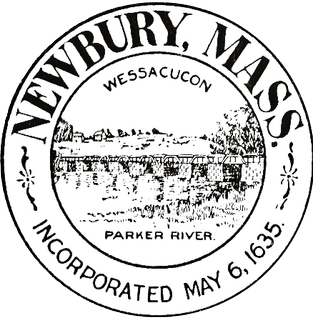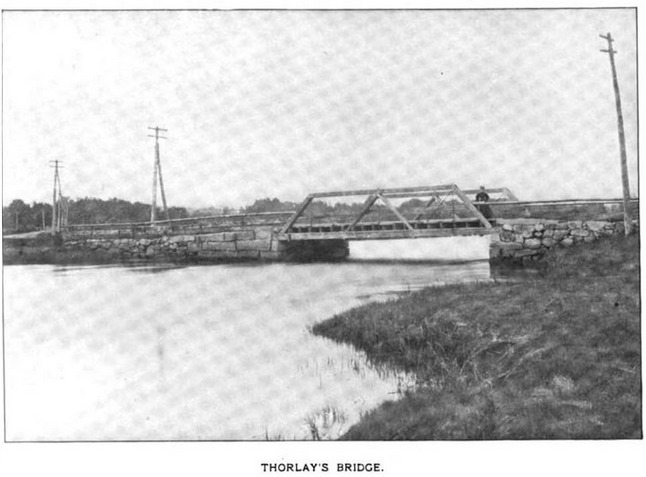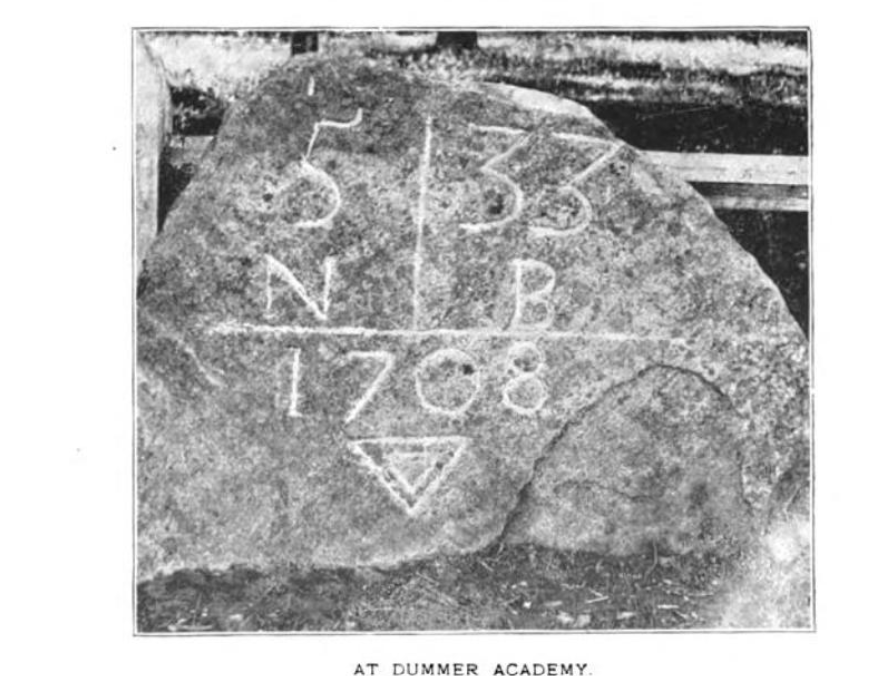Newbury is a historic town in Essex County, Massachusetts. It was settled by members of the Massachusetts Bay Colony in the early 17th century.
The town contains the villages of Plum Island, Byfield and Old Town (Newbury Center.) Newburyport used to be a part of Newbury until it became its own town in the 18th century.
The following is a timeline of the history of Newbury:
1635:
- In May, Newbury is settled when a group of colonists from Ipswich row to the mouth of the Parker River to establish a new agricultural and trading settlement and land near what is now the end of Cottage Road.
- A meeting house is built and, on September 6, a decree is passed that orders all houses to be located near the meeting house to protect the residents from Native Americans and wild animals.
- A burying ground is established near the meeting house and is now known as the First Settlers Burial Ground.
- Scotland Road is constructed and a common pasture is established along the road.
- On May 6, the town of Newbury is incorporated in the Massachusetts Bay Colony.
- On May 6, the General Court grants Richard Dummer 500 acres of land at the falls in Newbury and also grants him and John Spencer permission to build a mill there.
- On September 3, the General Court grants Francis Plummer a license to run a tavern and authorizes Richard Dummer to swear in a constable in Newbury.
1637:
- On November 20, Richard Dummer and John Spencer and 60 other colonists are condemned due to being followers of Anne Hutchinson and Reverend John Wheelwright and are ordered to turn over their guns and weapons to the constable. As a result, they decide to temporarily leave Newbury to avoid the punishment.
1638:
- On March 12, the General Court banishes the 60 colonists who were disarmed upon learning that they plan to return.
- Richard Dummer later returns to Newbury and submits to the laws and orders of the General Court.
1639:
- The General Court orders a road to be laid out from Boston to Newbury which comes to be known as Bay Road.
1646:
- The Noyes House is built for Reverend James Noyes on Parker Street.
1647:
- The meeting house is replaced by a new meeting house constructed on the present-day Upper Green.
1650:
- Robert Morse purchases land with an orchard on Hanover Street.
1651:
- Daniel Pierce purchases 300 acres of land on what is now Little’s Lane and turns it into a farm.
1652:
- The Atkinson – Little House, a Colonial-style clapboard house, is constructed for Robert Morse on Hanover Street.
1654:
- Sometime before 1654, Richard Thorlay builds a bridge over the Parker River and, on May 3, the General Court rules that Thorlay can charge a toll for livestock crossings over the bridge.
1658:
- Robert Morse sells his land and the Atkinson-Little House on Hanover Street to Amos Stickney. The house is later purchased by John Atkinson, who owns it until 1702, and then it is inherited by Abigail Little in the 1770s.
1661:
- The meeting house on the Upper Green is replaced with a new meeting house.
1663:
- A mill is constructed at Four Rocks Bridge on the Little River.
- A house is constructed by local school teacher Reverend John Woodbridge on High Road.
1670:
- The Stephen Swett – Ilsley House, a Colonial-style clapboard house, is built for farmer Stephen Swett on High Road and serves as a tavern known as the Blue Anchor Tavern. It is later purchased by Isaiah Ilsley in 1797.
- The Spencer – Pierce – Little House is built on Little’s Lane.
1675:
- The James Noyes House, a Colonial-style house, is built on Parker Road.
1678:
- The Tristram Coffin House, a Colonial-style clapboard house, is built for colonist Tristram Coffin on High Road.
- The Henry Sewall House is built for colonist Henry Sewall Jr on High Road. Sewall later raises his son, Judge Samuel Sewall, in this house.
1697:
- The Dr. Peter Toppan House, a Colonial-style house, is built for town physician Dr. Peter Toppan on High Road.
- A limestone deposit is discovered on Scotland Road and an arched cave formation on the site is later nicknamed Devil’s Den.
1700:
- The Newbury First Parish Burying Ground is established on High Street.
1702:
- The Old Byfield Parish Cemetery is established on Warren Street.
1704:
- The Abraham Adams House is built for Captain Adams, a local sea captain and shipbuilder, on Pearson Drive in Byfield.
1708:
- The Old Bay Road Milestone, a granite marker used to mark the route of the old Bay Road, is placed at the junction of Elm Street and Middle Road. The marker is engraved with the numbers 5 and 33 and the letters N and B underneath them, which means five miles to Newbury and 33 miles to Boston.
1710:
- The Benjamin Pearson House, a Colonial-style house, is built on Main Street.
- On October 28, the village of Byfield is incorporated by the General Court and is named after Judge Nathaniel Byfield.
1715:
- The William Dummer Mansion House is constructed on Elm Street in South Byfield.
1720:
- The Old Bay Road Milestone is placed on Green Street. The marker is engraved with the letters P and B and the numbers 28 and 37 underneath of them, which mean 28 miles to Portsmouth and 37 miles to Boston.
- The Old Bay Road Milestone, a granite marker used to mark the route of the old Bay Road, is placed on Boston Road. The marker is engraved with the number 36 and the letter B underneath it, which means 36 miles to Boston.
- The Old Bay Road Milestone is placed on Middle Road. The marker is engraved with the number 35 and the letter B underneath of it, which means 35 miles to Boston.
1725:
- The Oliver Goodrich House, a Colonial-style house, is built on Forest Street in Byfield.
- The Short House, a Georgian-style house, is built on High Road.
- The Pearson Tavern, a Colonial-style building that serves as a tavern, is built on Main Street.
1728:
- The Seddon Tavern is constructed on High Road.
1746:
- The Reverend John Tucker Parsonage is built for the Reverend Tucker on High Road.
1750:
- The William H. Moody House, a Colonial-style house, is built on Central Street in South Byfield.
- The Pearson House, a Colonial-style house, is established on Main Street.
1753:
- Newbury Neck Cemetery is established on Newbury Neck Road.
1758:
- A wooden bridge is built on what is now High Road over the Parker River.
1762:
- A red school house is built on the Dummer farm on Elm Street.
1763:
- On March 1, Governor Dummer Academy is established in Byfield when the school house on the Dummer farm opens to the public.
1764:
- The Hale – Boynton House, a Georgian-style house, is built on Middle Street.
- Newburyport separates from Newbury and is officially incorporated as a town in the Province of Massachusetts Bay.
1767:
- The Nicholas Pettingill Blacksmith Shop is built for local blacksmith Nicholas Pettingill on the corner of Rolfe Lane and High Road.
1775:
- The Spencer – Pierce Little Barn is built on the Pierce Farm on Little’s Lane.
- The Riverview Farm is established on Main Street.
1784:
- The wooden bridge over the Parker River on High Road is rebuilt.
1785:
- The G. Little House, a Georgian-style house, is built on Green Street.
1800:
- The Newman House, a Georgian-style house, is built on the Old Town Hill Farm on Newman Road.
1804:
- The Byfield Snuff Company Mill No. 1 is built on Larkin Road in Byfield.
1806:
- A new church is built on High Road which replaces the meeting house.
1825:
- The Deacon N. Little House, a Greek Revival-style house, is built on Green Street.
1827:
- The bridge over the Parker River is repaired to make it safer for travelers.
1828:
- On April 7, the town of Newbury purchases a farm and turns it into a Town Farm for poor residents. All residents receiving town assistance are relocated to the farm.
1830:
- A sawmill is built on Lower Main Street and is later purchased by the Pearson family and converted into the Byfield Snuff Company Mill No. 2 in 1860.
- The Governor Dummer Academy Building is constructed on Middle Road.
1840:
- The Friendly Market, a Greek Revival-style building that serves as a grocery store, is constructed on Main Street in Byfield.
1843:
- The Reverend Leonard Withington House, a Greek Revival-style house, is built on High Road.
1850:
- The Gospel Hall, a Greek Revival-style meeting hall, is built on Central Street.
- The Little House, a Greek Revival-style house, and a barn is built on Green Street.
- A Greek Revival-style house is built on Main Street in Byfield that later serves as a Mobile gas station.
- The population of Newbury is 4,426.
1858:
- The Thorlay Bridge is rebuilt on Middle Street.
1860:
- A sawmill is constructed on River Street and is later purchased by the Byfield Snuff Company in 1870 and converted into a tobacco grinding facility.
- The population of Newbury is 1,444.
1865:
- The Benjamin Perkins Creasy House is built on High Road.
1868:
- On January 26, the church is destroyed in a fire
1869:
- The First Parish Church of Newbury, an Italianate-style church building, is built on High Road.
1870:
- The U.S. Post Office – Byfield Center Branch is built on Main Street.
- The C. Lunt House, a Second Empire-style house, is built on the Woodbridge Farm on High Road.
- The H.S. Adams House, a Victorian Eclectic-style house, is built on High Road.
- The population of Newbury is 1,430.
1872:
- The W. Coffin House is built on Scotland Road.
- The S. Thurlow House and farm are built on Scotland Road.
1874:
- Local farmer Albert Adams discovers a vein of silver ore on his farm on Scotland Road. Businessman Mr. Chipman purchases the land from Adams to establish a silver mine.
- The Chipman Silver Mine is established on Scotland Road.
1875:
- On June 2, a parade is held as the first batch of silver ore, about 160 tons, is carted through town on three horse-drawn wagons and loaded onto a ship to be processed in New York.
1876:
- The Luther Dame House, an Italianate/Second Empire-style house, is built on High Road.
1879:
- Operations cease at the Chipman Silver Mine due to the low quality and low value of the silver ore being extracted there and the high cost of production.
1880:
- The Hale Knight House, an Italianate-style house, is built on High Road.
- The population of Newbury is 1,566.
1888:
- Chipman opens the Chipman Silver Mine again using more modern equipment but the silver ore is still low quality and not very valuable so it closes shortly after.
1890:
- The population of Newbury is 1,427.
1898:
- The Woodbridge Grammar School, a Colonial Revival-style school building, is constructed on High Road on the former site of Reverend Woodbridge’s house from 1663.
1900:
- The Newbury Revolutionary War Scroll, a memorial plaque dedicated to the local Revolutionary War soldiers, is erected on High Road.
- The Burke House, a Colonial/Queen Anne-style house, is built on Green Street.
- The Plum Island Turnpike is constructed in Newbury.
- The population of Newbury is 1,601.
1901:
- The Byfield Elementary School, a two-story Colonial Revival-style building, is built on Lunt Street.
1902:
- The Landing Place of the First Settlers Monument is erected on Cottage Road.
1904:
- The Newbury Town Hall and Police Station, a Colonial-style municipal building, is constructed on High Road.
1905:
- The First Settlers Monument is erected on the Lower Green
1910:
- The Newbury Soldiers and Sailors Monument is erected on High Road.
- The population of Newbury is 1,482.
1911:
- The Hanover Street Bridge over Little River is constructed on Hanover Street.
- The Ilsley family sells the Stephen Swett – Ilsley House to Historic New England.
- Kents Island Road Bridge is constructed on Kents Island Road.
1920:
- The Chipman Silver Mine briefly reopened again sometime in the early 1900s but failed to be profitable again and closed again in 1920.
- The population of Newbury is 1,303.
1928:
- The Short House on High Road is purchased by Historic New England.
1929:
- The Coffin family sells the Tristram Coffin House to Historic New England.
1930:
- The Parker River Bridge – High Road Bridge is rebuilt over on High Road.
- The population of Newbury is 1,530.
1933:
- The Seddon Tavern is moved to the Newbury Lower Green but is destroyed in a fire shortly after.
1937:
- The State Street Bridge over the Boston and Maine railroad line is constructed on State Street.
1940:
- The Seddon Tavern is reconstructed on the Newbury Lower Green.
- The population of Newbury is 1,599.
1948:
- The Nicholas Pettingill Blacksmith Shop is moved to Green Street.
1950:
- The Newbury World War II Memorial is erected on High Road.
- The barn on the Little property on Green Street is remodeled into a Colonial Revival-style house.
- The population of Newbury is 1,994.
1960:
- The population of Newbury is 2,519.
1961:
- White’s Bridge is built on Newman Road.
1965:
- Historic New England opens the Stephen Swett – Ilsley House to the public as a historic house museum.
1970:
- The population of Newbury is 3,804.
1972:
- The old house on the Town Farm is demolished to make way for the construction of Triton Regional High School.
1973:
- The Donald Wilkinson Bridge is built on the Plum Island Turnpike and is named after local Vietnam soldier Donald Wilkinson who was killed in a plane crash in Vietnam.
1980:
- The population of Newbury is 4,529.
1984:
- The Larkin Road Bridge is built on Larkin Road.
1990:
- The population of Newbury is 5,623.
2000:
- The population of Newbury is 6,717.
2010:
- The population of Newbury is 6,666.
2020:
- The population of Newbury is 6,716.
Sources:
Currier, John James. The History of Newbury Massachusetts 1635 – 1902. Damrell & Upham, 1902.
Guide to Historic Newbury, file:///C:/Users/16039/Downloads/hist._brochure.pdf
Little, N. Map of Mining Lands at Newbury, near Newburyport, Essex County, Massachusetts. Hatch Lith Co, 1875
Hale, Albert. Old Newburyport Houses.W.B. Clarke Co, 1912.
Sargent, Bill. “Sargent’s View: Curious History of the Devil’s Den in Newbury.” Newburyport Daily News, 30 Nov. 2018, newburyportnews.com/opinion/columns/sargents-view-curious-history-of-the-devils-den-in-newbury/article_f26977f3-fef1-559e-9a85-3251fd5d5a0d.html?hl=en&gbpv=1&dq=judge+byfield+named+after+sewall+milestone&pg=PA46&printsec=frontcover
“Commerce.” Newbury Historical Commission, newbury1635.org/commerce.html
“Monuments.” Newbury Historical Commission, newbury1635.org/monuments.html
“Houses.” Newbury Historical Commission, newbury1635.org/houses.html
Callahan, Joe. “After the Silver Mine Parade It Was All Downhill.” Daily News, 8 Oct. 2015, newburyportnews.com/opinion/after-the-silver-mine-parade-it-was-all-downhill/article_d58acfe2-0e2f-50ae-9645-2808b808b826.html
Solis, Jennifer. “Newbury Dedicates Bridge to Vietnam Veteran.” Newburyport News, 6 Oct. 2017, newburyportnews.com/news/local_news/newbury-dedicates-bridge-to-vietnam-veteran/article_d010194a-f097-529d-a8bb-a888532350ce.html
“Our History.” First Paris Church of Newbury, firstparishofnewbury.org/our-history/











It appears that the population cited for 1850 is in error (4426) as the 1860 population is listed as 1444.
RE: my question about the large change in population from 1850 to 1860
After reading the Newburyport history, I see that much of Newbury was ceded to Newburyport, thus the significant change in population of Newbury.
I loved all the old photos along with the history.